
Pyramid of the Sun Mexico
The Pyramid of the Sun at Teotihuacan, Mexico, is our fourth stop in Journeys to Discovery.
The massive stone structures built in the area, were treated with awe and reverence by the people of Central America.
When the Maya were questioned by the Spanish conquistadors on the builders of these ancient constructions, they were told that the gods themselves had created them.
Upon the arrival of the Spanish in the 16th century, the Pyramids of Teotihuacan had already been existence for over a millennium.
The two most famous structures at the site are the Temples of the Sun and the Moon. According to Aztec tradition, the universe could trace its ancestry to this spiritual place.
More temples would be discovered here, than in any other Mesoamerican city.
During the 5th and 6th centuries, Teotihuacan had become one of the most dominant societies in the Americas. Their capital of the same name, is located northeast of Mexico City. The city had a population that was estimated to be between 100,000 and 200,000 at its apex, which was around 450 C.E.
This would of made it the 6th largest city in the world, at the time.
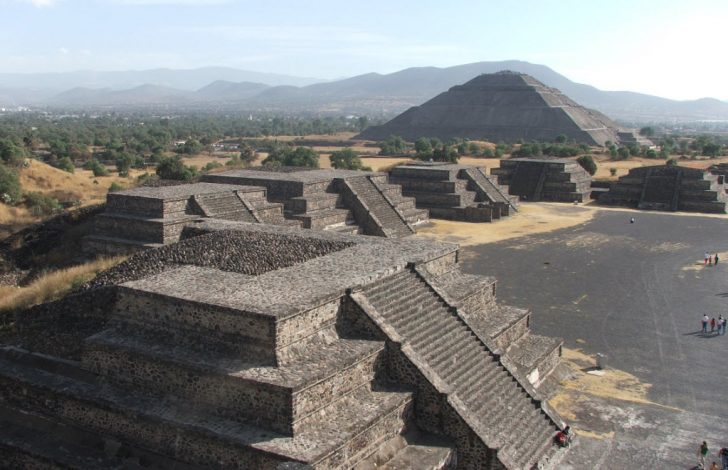
Pyramid of the sun at Teotihuacan
The power and prestige of Teotihuacan is unprecedented, in the history of Central America.
The city was highly organized and was strictly governed by the secular and religious leaders of the time. The priests formed an intellectual elite and were skilled astronomers. They kept track of major events and religious ceremonies throughout the year, decades and centuries of city life.
Most of the buildings in the city were plastered, with the pyramids being painted bright red. The latter were embellished with brightly painted and sculptured motifs. They often depicted elaborate renderings of feathered serpents and other gods associated with the culture.
Much of the commerce of the city and the center of life was focused on a number of markets. The largest found, was in an open compound off the Street of the Dead, opposite the Temple of Quetzalcoatl.
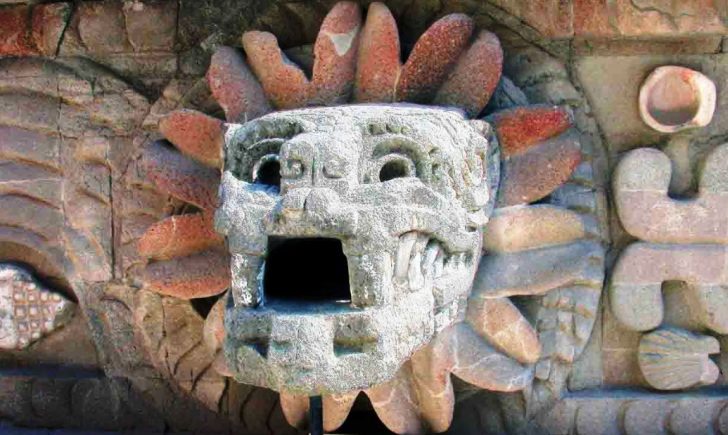
Temple of Quetzalcoatl Mexico
Teotihuacan lay in the middle of the extensive Central American trade in obsidian volcanic glass. Knives and blades of fine quality, were found in great abundance here.
The city was also famous for its beautiful pottery, which was sold to areas hundreds of miles away.
Although the people of the Americas built pyramids as early as 1000 BCE (Before the Common Era), the Temples of the Sun and Moon were built between the years 01 CE (Common Era) and 250 CE. The Pyramid of the Sun located in central Mexico, has become the most famous single pyramid in all of Latin America.
It was by far the largest building in the New World, prior to the European arrival.
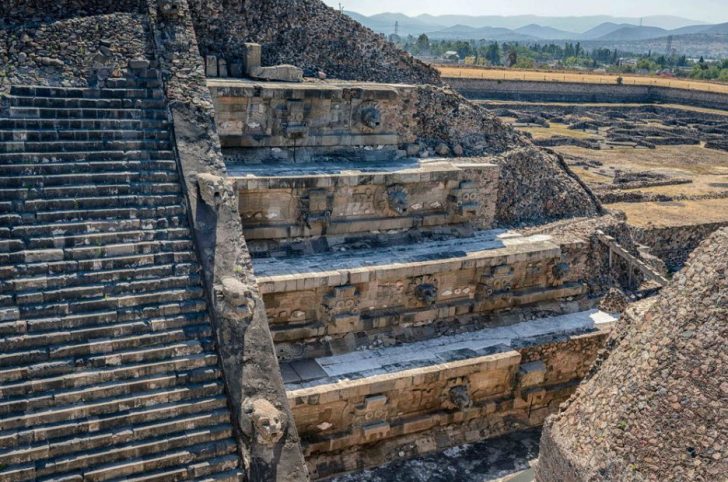
Temple of Quetzalcoatl in Teotihuacan
Despite the notoriety over the pyramids in Egypt, there are more pyramid like structures in the Americas, than the rest of the world combined.
Pre-Colombian pyramids unlike their Egyptian counterparts, served as more than mere tombs.
Although many were used as burial chambers for the kings of old, they also housed the gods and played a military defensive role in many early societies.
In many cases, the pyramids would form the center of public life. Numerous ceremonies would take place on them.
Holy rituals including human sacrifice were made on top of them, with the spent bodies often flung down the abundant steps.
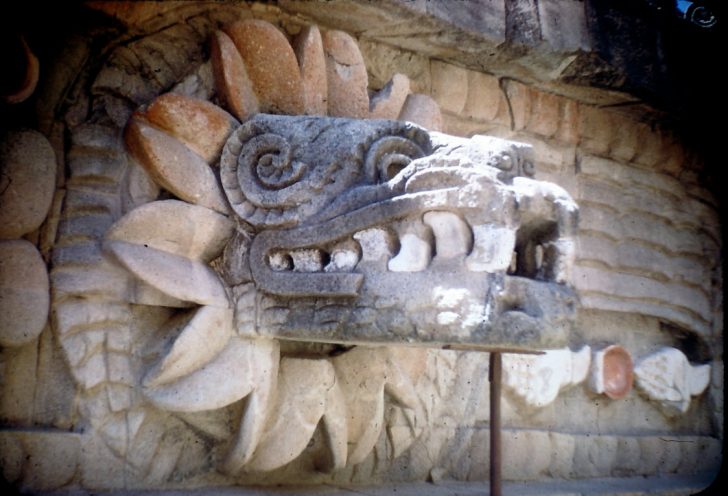
Temple of Quetzalcoatl
As with other pyramids in the area, the Pyramid of the Sun was constructed around an inner core of rubble held in place by retaining walls. The walls were then faced with adobe bricks, and finally covered with limestone.
The base of the pyramid measures 730 feet (222.504 meters) on each side. There are five stepped terraces that rise to a height of some 234 feet (71.2 meters). It is the third largest pyramid in the world.
To put it into perspective, if one stands at the bottom of the pyramid and looks upwards, one can just barely make out people standing at the top of the monument.
In comparison,the Great Pyramid in Egypt is 755.9 feet (230.4 meters) long on each side. The main difference between the two constructions is the elevation. The Egyptian pyramid at Giza was estimated to be 480.6 feet (146.5 meters), when it was originally completed.
Today, it can be measured at 455.4 feet (138.8 meters).

Pyramid of the sun at Teotihuacan
Unknown to many travelers, within the present Pyramid of the Sun, is an earlier pyramid of almost the same size. It was common practice to rebuild around earlier pyramids and temples, as way to glorify a new ruler and his reign. It was seen as a important step, in maintaining and renewing the new king’s relationship with the gods.
In 1971, archaeologists doing excavation at the site, discovered a cave underneath the Pyramid of the Sun. This formation led to a enclosure in the shape of a four-leaf clover.
Artifacts found here and in the cave, provide evidence that the chamber was used as a shrine.
It was in use, long before the pyramid would be built over it.
The Pyramid of the Sun it is thought, took over a century to build and over 3.6 million feet (1.1 million cubic meters) of adobe bricks were used in the process. The exterior has protrusive brickwork, designed to provide the base for some 197,000 square feet (60,000 meters) of stucco. In earlier times, this area was painted and adorned with colorful murals.
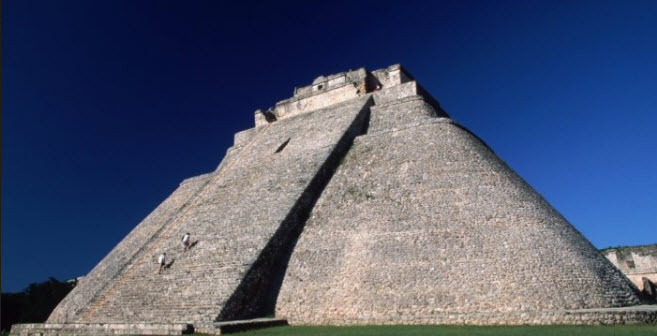
Pyramid of the magician
The artwork here was intensely religious as with other public buildings.
What is amazing about the Pyramid of the Sun, is that is was constructed without the use of pack animals or metal tools.
It is important to note, that there is a present day deviation from the original form and height, the result of the extensive archaeological work carried out by Leopoldo Batres in the early 20th century. Most notably adding a 5th layer close to the peak.
The Pyramid of the Moon, is built on a smaller scale. It is located on the north end of the city, along what is called the Avenue of the Dead.
Teotihuacan also contains a far smaller stone covered stepped pyramid, known as the Temple of the Feathered Serpent. It is identified as being an earlier form of the Aztec god Quetzalcoatl. The dedication ceremony for this noteworthy building, was held around 200 C.E. It has been told that some 200 human sacrifices were made, to commemorate the occasion.
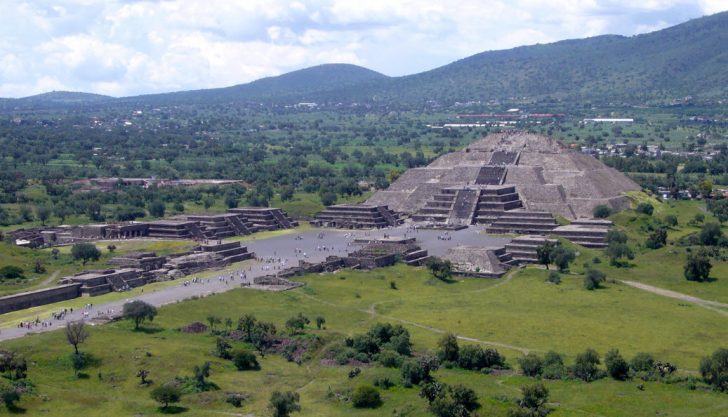
Pyramid of the Sun at Teotihuacan
In another comparison to the Egyptian pyramids at Giza, there are also three main pyramids that can be found at Teotihuacan.
Teotihuacan would later decline between the 7th and 10th centuries and would eventually be abandoned. The first signs of strain appear about 650 C.E. The population was already in full decline. Nearly fifty years later, some great calamity apparently took place.
Inhabitants of the city for the first time in centuries, were fewer than 70,000. Many residents had previously left the city, moving to the east.
Around 700 C.E. the city was deliberately burnt and parts of it were destroyed. After that, many buildings collapsed and the pyramids were gradually reclaimed, by dense tropical vegetation. However, the memory of the grandeur and majesty of Teotihuacan and the Pyramid of the Sun would remain.
How To Get There
Most tourists come from Mexico City. The distance to Teotihuacan is 71.6 kilometers (44.49 miles). The site is about 1 hour and 51 minutes in driving time from the capital depending on traffic. Tours will often leave from popular sites, within the Mexico City. Keep in mind many tour operators will actually use public transport, to bring you to Teotihuacan.
One can also easily take a public bus to the site as well. The cost of this mode of transportation is 92 Mexican pesos, the equivalent of $4.78 USD (United States Dollar) It pays for a round trip ticket, but leaves at a specific time. Buses start running at 6 am and one leaves every 20 minutes.
Buses will run until at least 6 pm, for the return trip.
Hours of Operation
The park is open every day of the week from 9:00 am to 5 pm local time. The recommended time needed to view the park is from two to three hours, but you may well want to stay longer.
If you wish to climb the Sun Pyramid (still permitted at this time), a guard rail is provided for the 248 steps. It is recommended to do this early, before it gets too warm. A traveler if in fit condition, can traverse the steep steps quite easily.
If you arrive before 10:30 am, you can normally avoid larger crowds of people.
It is advised not to go on Sundays. The day permits free admission for Mexican residents and will likely be crowded.
Admission And Entrance Fees
A small group tour (no more than 15 persons) with a knowledgeable tour guide, is recommended for less experienced travelers. It can be booked over the internet, for as little as $28 USD. This price includes all admission fees.
If you prefer to visit the site on your own, the cost to enter the site and the museum will be 65 Mexican pesos, the equivalent ($3.38 USD). There is an additional charge if you will be recording video.
A licensed guide can be employed near the entrance to the site, for about 800 Mexican pesos ($41.60 USD), but is not necessary.
By Jeffrey Hagenmeier

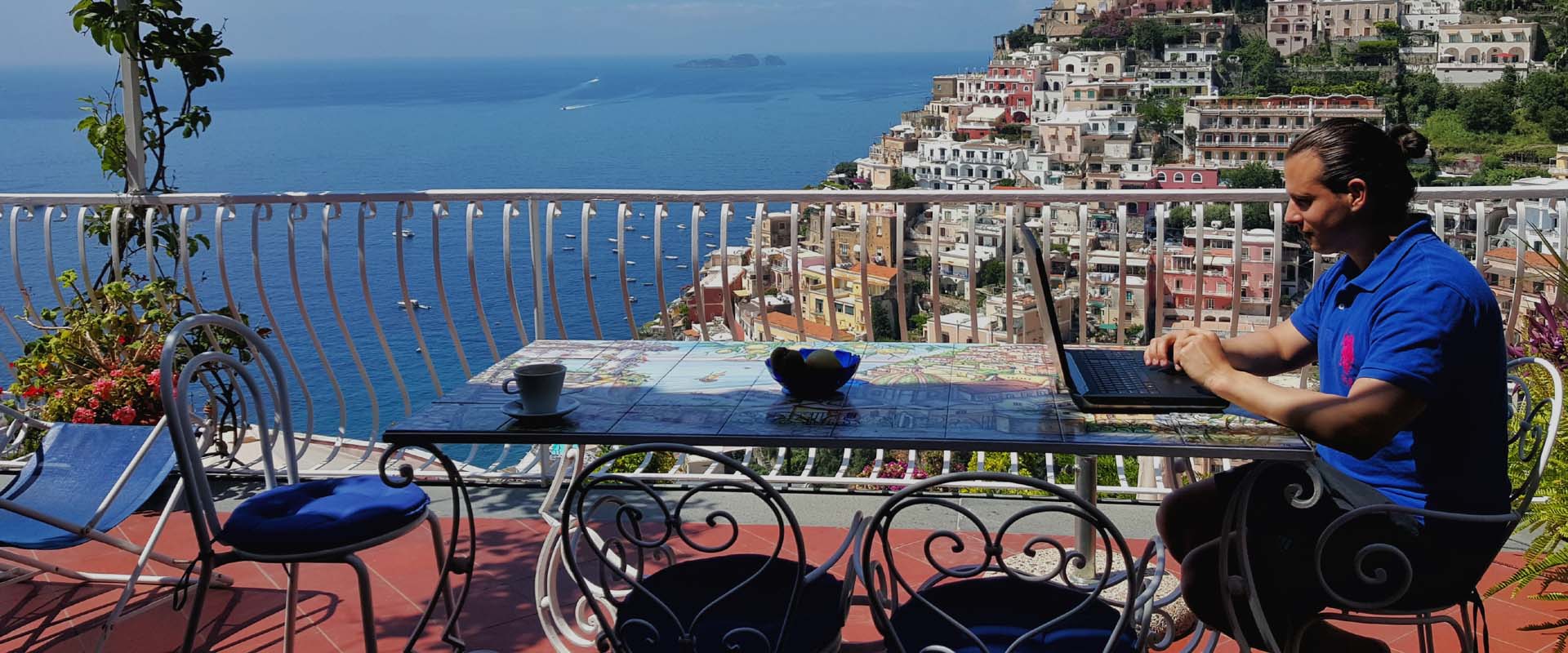
Why do you have a pucture of the Magicians Pyramid, which is in Uxmal, Yucatan, and not in Teotihuacan?
The pyramid looks stunning. Adding to my travel bucket list!!
Love this old architecture, climbing to the top gives fantastic views. These ruins absolutely are magnificent piece of history
This is really one of the amazing facts of mexico. I heard that largest pyramid in the world in the mexico, is that one?
The largest such structure in the world is located in Mexico. It is known as the Great Pyramid of Cholula. It can be found in Puebla, Mexico. It is mostly covered by layers of dirt and has a church built on top of it, constructed in 1594. It is estimated to be four times the size of the Great Pyramid of Giza, located in Egypt and was built more than 2,300 years ago. It was only recently rediscovered in the early 1900s, having been abandoned sometime between the 7th and 8th centuries C.E.
A truly epic place. I backpacked it too and toured the main sights of Mexico City as well. Keep up the good blogs and good work. Safe travels. Jonny